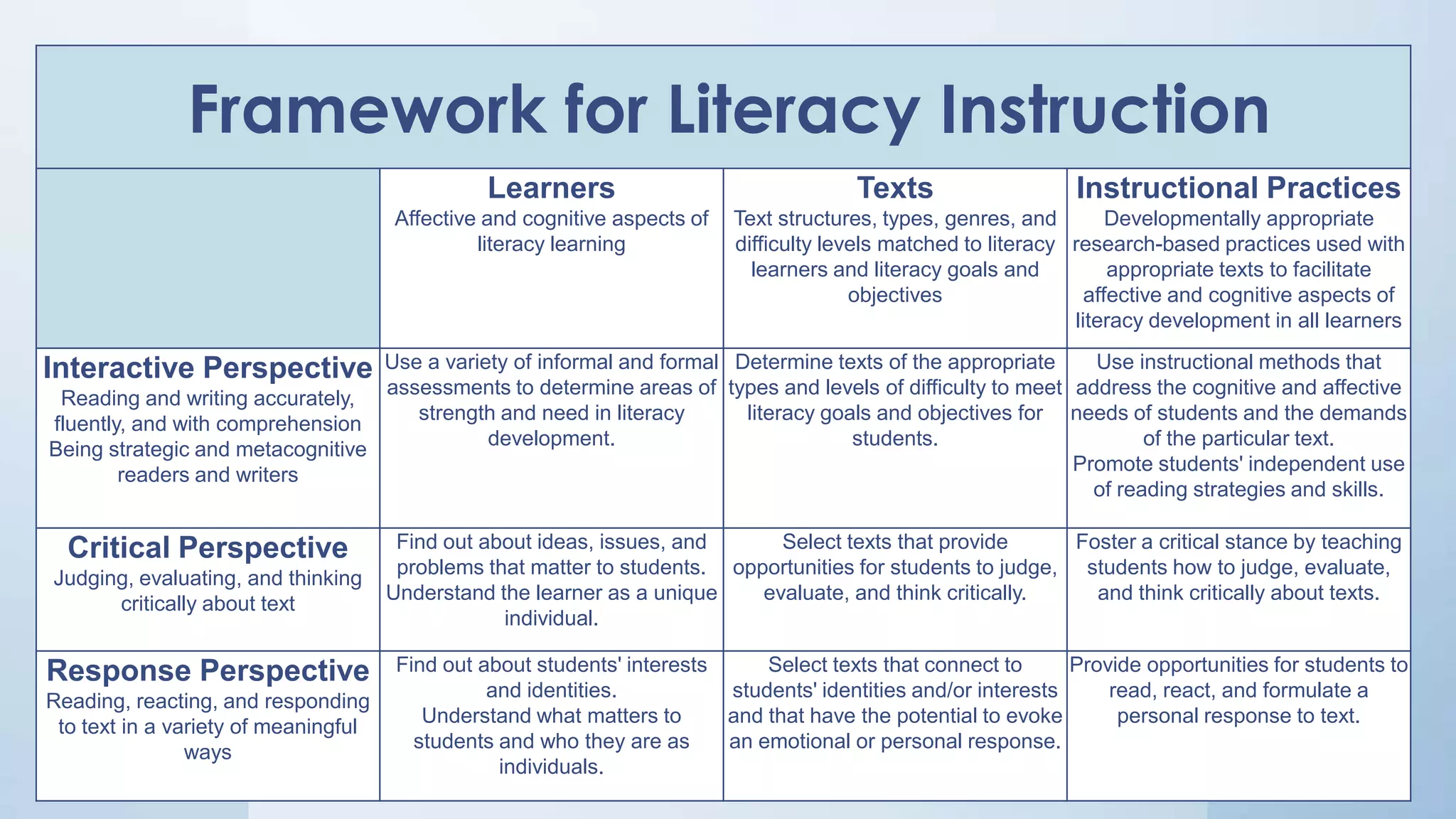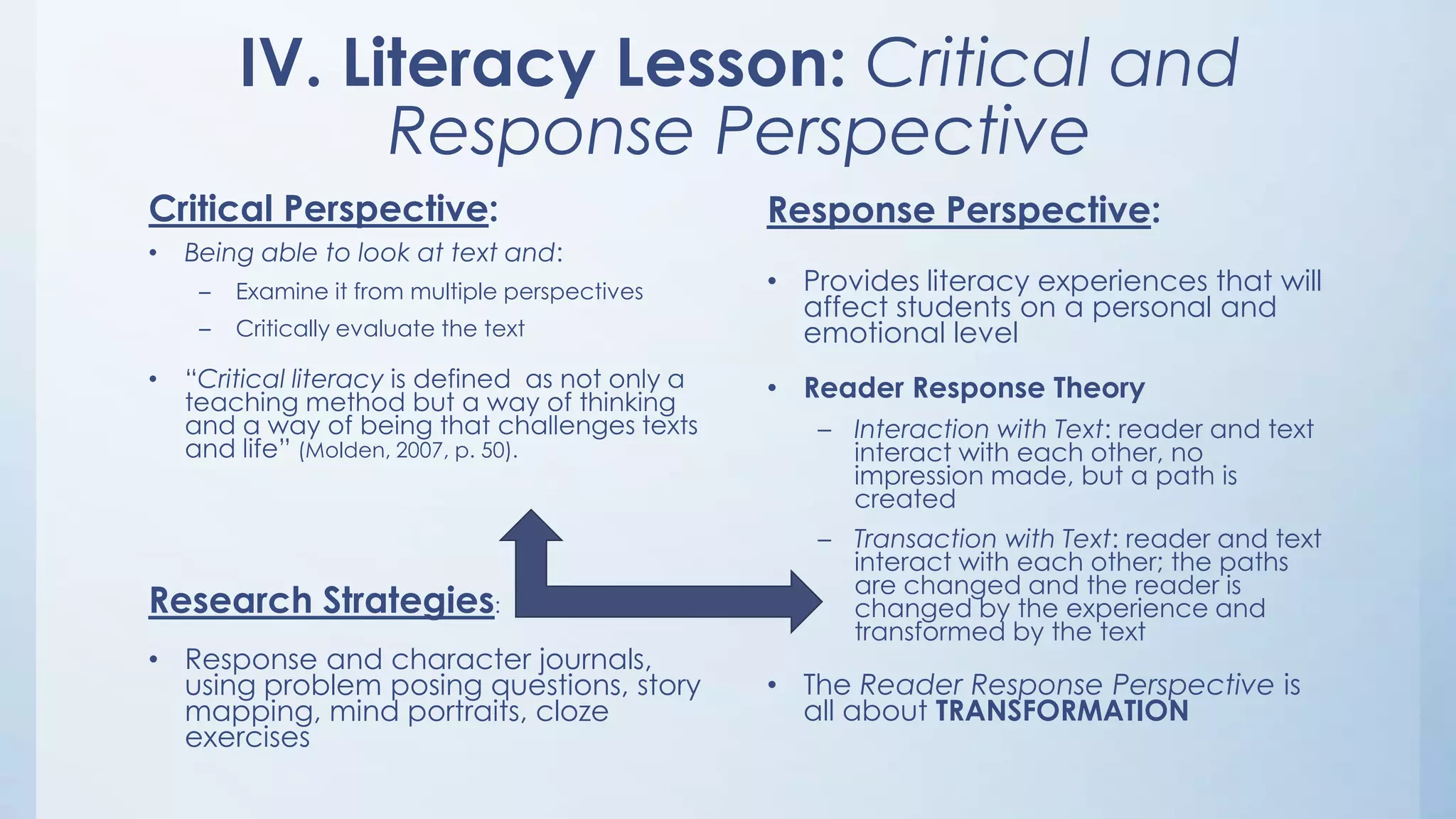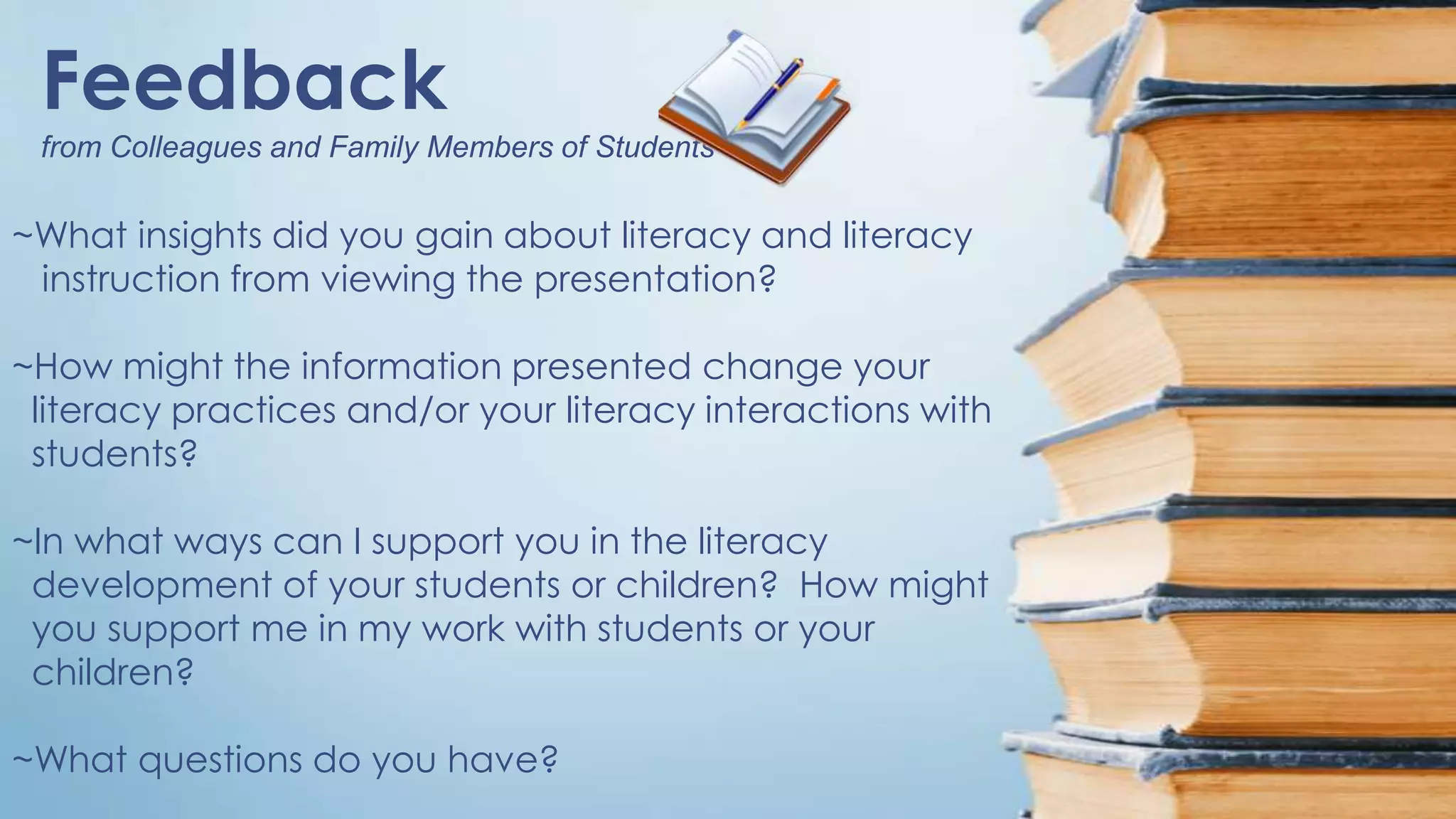The document discusses creating a literate environment for students in pre-K through 3rd grade. It emphasizes the importance of getting to know individual students in order to best support their literacy development. Teachers should learn about students' backgrounds, interests, and identities to select texts that appeal to them and facilitate instructional practices like read-alouds that foster engagement. The document also provides a framework for literacy instruction that addresses cognitive and affective needs through interactive, critical, and response-based perspectives. Overall, the key aspects of a literate environment include knowing students well on an individual level and using instructional strategies that account for their unique experiences and identities.



![I. Getting to Know Literacy Learners (PreK-3)
All people have experiences that shape themselves as literate
beings.
Analysis
• Getting to know readers includes discovering what kind of
background knowledge they bring with them to the
classroom and identifying students as readers, writers, and
speakers, rather than running into preconceived ideas.
• The information can be obtained in many ways- students
each bring in [five] objects from home and talk with the class
about them, Reading Inventories, etc.
• Conducting activities to get to know students better also
helps with instruction and creates a positive rapport between
teacher and student- which lets the student know they are
important.](https://image.slidesharecdn.com/creatingaliterateenvironment-131216235833-phpapp02/75/Creating-a-Literate-Environment-4-2048.jpg)
![Research-Based Practices
• Reading Inventories
– Part of instruction: observations, anecdotal
notes, conferences, checklists, rubrics, running
records
Research
Laureate Education, Inc. (Producer). (2011).
Literacy autobiographies [Video webcast].
Retrieved from
https://class.waldenu.edu/webapps/portal/fram
eset.jsp?tab_tab_group_id=_2_1&url=%2Fwebap
ps%2Fblackboard%2Fexecute%2Flauncher%3Fty
pe%3DCourse%26id%3D_4067480_1%26url%3D
Laureate Education, Inc. (Producer). (2011).
Getting to know your students [Video webcast].
Retrieved from
https://class.waldenu.edu/webapps/portal/fram
eset.jsp?tab_tab_group_id=_2_1&url=%2Fwebap
ps%2Fblackboard%2Fexecute%2Flauncher%3Fty
pe%3DCourse%26id%3D_4067480_1%26url%3D
– Published: Scholastic Reading Inventory (SRI),
Developmental Reading Assessment (DRA),
Elementary Reading Attitude Survey (ERAS)](https://image.slidesharecdn.com/creatingaliterateenvironment-131216235833-phpapp02/75/Creating-a-Literate-Environment-5-2048.jpg)
![II. Selecting Texts
• Analysis
– A Literacy Matrix is a tool that allows
teachers to take texts they are using with
their students and map them on the matrix,
in order to ensure a full balance of the kinds
of materials students are engaging with.
– Consider the difficulty of the text:
readability, text length, text structure, size of
print, and visual support.
NarrativeLinguistic
InformationalLinguistic
NarrativeSemiotic
InformationalSemiotic
– The matrix is helpful in connecting what is
being done with other things in the
classroom and in student learning; it keeps
the goals of the teacher in focus.
• Research
– Laureate Education, Inc. (Producer). (2011).
Analyzing and selecting texts [Video
webcast]. Retrieved from
https://class.waldenu.edu/webapps/portal/
frameset.jsp?tab_tab_group_id=_2_1&url=%
2Fwebapps%2Fblackboard%2Fexecute%2Fl
auncher%3Ftype%3DCourse%26id%3D_4067
480_1%26url%3D](https://image.slidesharecdn.com/creatingaliterateenvironment-131216235833-phpapp02/75/Creating-a-Literate-Environment-6-2048.jpg)


![References
Laureate Education, Inc. (Producer). (2011). Analyzing and selecting texts [Video webcast].
Retrieved from
https://class.waldenu.edu/webapps/portal/frameset.jsp?tab_tab_group_id=_2_1&url=%2Fwebapps%2Fblackboard%2Fexecute%2Flaunche
r%3Ftype%3DCourse%26id%3D_4067480_1%26url%3D
Laureate Education, Inc. (Producer). (2011) Critical literacy [Video webcast]. Retrieved from
https://class.waldenu.edu/webapps/portal/frameset.jsp?tab_tab_group_id=_2_1&url=%2Fwebapps%2Fblackboard%2Fexecute%2Flauncher%3Ftype%3DCo
urse%26id%3D_4067480_1%26url%3D
Laureate Education, Inc. (Producer). (2011). Getting to know your students [Video webcast]. Retrieved from
https://class.waldenu.edu/webapps/portal/frameset.jsp?tab_tab_group_id=_2_1&url=%2Fwebapps%2Fblackboard%2Fexecute%2Flauncher%3Ftype%3DCo
urse%26id%3D_4067480_1%26url%3D
Laureate Education, Inc. (Producer). (2011). Literacy autobiographies [Video webcast]. Retrieved from
https://class.waldenu.edu/webapps/portal/frameset.jsp?tab_tab_group_id=_2_1&url=%2Fwebapps%2Fblackboard%2Fexecute%2Flauncher%3Ftype%3DCo
urse%26id%3D_4067480_1%26url%3D
Laureate Education, Inc. (Producer). (2011). Response perspective [Video webcast]. Retrieved from
https://class.waldenu.edu/webapps/portal/frameset.jsp?tab_tab_group_id=_2_1&url=%2Fwebapps%2Fblackboard%2Fexecute%2Flauncher%3Ftype%3DCo
urse%26id%3D_4067480_1%26url%3D
McKenna, M.C., & Kear, D.J. (1990). Measuring attitude toward reading: A new tool for teachers. The Reading Teacher, 43(9), 626-639.
Molden, K. (2007). Critical literacy, the right answer for the reading classroom: Strategies to move beyond comprehension for reading improvement.
Reading Improvement, 44(1), 50-56.
Tompkins, G.E. (2010). Literacy for the 21st century: A balanced approach (5th ed.). Boston: Allyn & Bacon.
Walden University. (2013). Framework for literacy instruction. Retrieved from
https://class.waldenu.edu/webapps/portal/frameset.jsp?tab_tab_group_id=_2_1&url=%2Fwebapps%2Fblackboard%2Fexecute%2Flauncher%3Ftype%3DCo
urse%26id%3D_4067480_1%26url%3D#global-nav-flyout](https://image.slidesharecdn.com/creatingaliterateenvironment-131216235833-phpapp02/75/Creating-a-Literate-Environment-9-2048.jpg)
